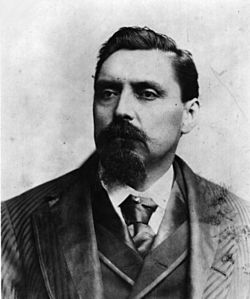John Brown (Seminole chief) facts for kids
Quick facts for kids
John Brown
|
|
|---|---|

John Brown
|
|
| Last Principal Chief of the Seminole Tribe of Oklahoma, 1885-1901, 1905-1906 leader | |
| Preceded by | Big John Chupco / John Jumper |
| Succeeded by | Hulputta Micco |
| Personal details | |
| Born | October 23, 1842 Near Fort Gibson, Oklahoma |
| Died | October 21, 1919 Sasakwa, Oklahoma |
| Spouses | Lizzie Jumper, and two other wives |
| Relations | Brother, Andrew Jackson Brown, sister, Alice Brown Davis |
| Children | Twelve known children |
| Parents | Dr. John Frippo Brown, Lucy Nancy Redbeard |
| Known for | Confederate States Army officer |
John Frippo Brown (born October 23, 1842 – died October 21, 1919) was an important leader of the Seminole Nation. He served as an officer in the Confederate States Army during the American Civil War. Later, he was elected as the last main chief of the Seminole Nation. He held this important role from 1885 to 1901, and again from 1905 to 1906.
Contents
John Brown's Early Life
John Brown was born on October 23, 1842. His birthplace was near Fort Gibson, Oklahoma. His mother, Lucy Nancy Greybeard, was Seminole. His father, Dr. John Frippo Brown, Sr., was a doctor from Scotland. John was the oldest of seven children.
His family was mixed-race. They grew up learning about both cultures. But they lived among the Seminole people. They thought of themselves as Seminole. His sister, Alice Brown Davis, later became the first woman chief of the Seminoles in 1922. His brother, Andrew Jackson Brown, also served the tribe as treasurer.
John Brown fought in the Confederate States Army. He was an officer under the Seminole chief John Jumper. After the war, he helped with peace talks. He signed the Reconstruction Treaty of 1866. This treaty helped rebuild relations after the war.
In 1867, both of John's parents died. They passed away during a cholera sickness. His 15-year-old sister Alice then moved to Wewoka. She went to live with John.
Becoming a Seminole Leader
After the Civil War, the U.S. government recognized Big John Chupco as chief. But most of the Seminole tribe followed John Jumper. The tribe soon elected John Jumper as their chief. He resigned not long after.
John Brown was then elected chief. He was part of the Tiger Clan. He was also John Jumper's son-in-law. His younger brother, Andrew Jackson Brown, became the tribe's treasurer.
John Brown served as the tribe's "governor" from 1885 to 1901. Then, another leader named Hulputta Micco was elected. After Micco died in 1905, John Brown was re-elected. He served until 1906. In 1906, the tribal government was ended. This was done to prepare for Oklahoma to become a state.
Important Work as Chief
As chief, John Brown worked on important agreements. In 1897, he negotiated with the Dawes Commission. This agreement divided tribal land into smaller plots. Each family would get their own piece of land. This was part of a plan to help Native Americans fit into the larger American culture.
In 1905, he was a delegate to the Sequoyah Constitutional Convention. Native Americans in Indian Territory wanted to create their own state. They wrote a constitution for an all-Indian state. But the U.S. Congress did not approve their plan.
John Brown often traveled to Washington, D.C. He met with national leaders there. During these visits, he became friends with U.S. President Theodore Roosevelt.
His Family and Community Role
John Brown owned a ranch southeast of Wewoka. He also ran the Wewoka Trading Company. He managed it with his brother Andrew. John was also a minister. He was the pastor of the Spring Baptist Church from 1894 until he died.
He first married Lizzie Jumper. Her father had been a Seminole chief. After Lizzie died, John married two more times. He had at least 12 children.
Later Years
John Frippo Brown passed away on October 21, 1919. He died in Sasakwa, Oklahoma.

